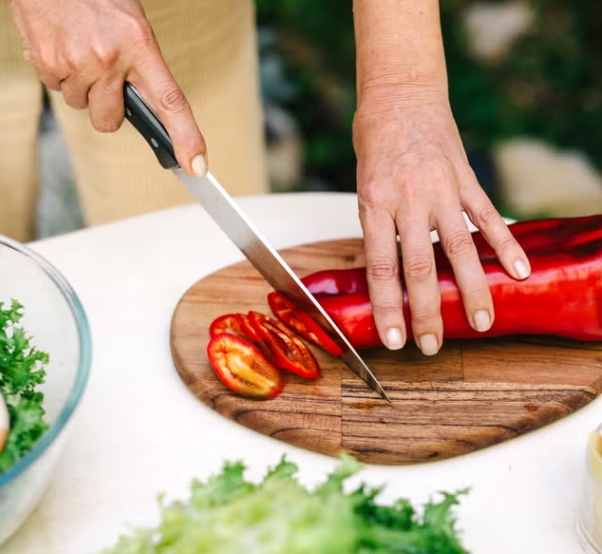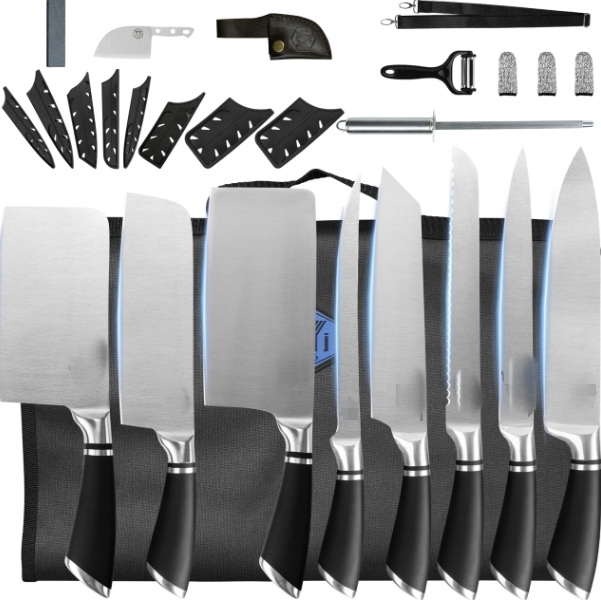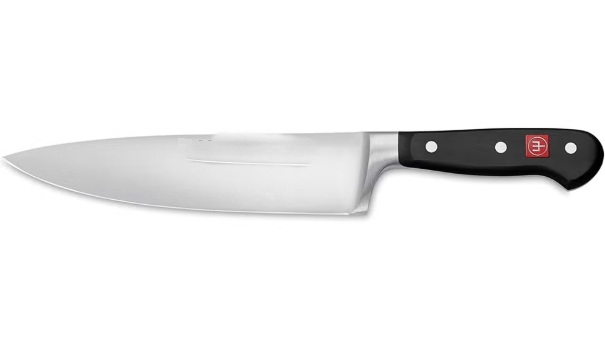

Views: 222 Author: Ella Publish Time: 2025-05-05 Origin: Site








Content Menu
● Understanding Knife Sharpness: Sharpening vs. Honing
● How Often Should You Sharpen Your Chef Knife?
● Factors Influencing Sharpening Frequency
>> Knife Steel Quality and Hardness
● How to Tell When Your Chef Knife Needs Sharpening
● Best Practices for Sharpening Your Chef Knife
>> Sharpening Tools and Methods
>> Sharpening Steps with a Whetstone
● Maintenance Tips to Extend Sharpness
● Common Mistakes to Avoid When Sharpening
● How to Hone a Chef Knife Correctly
● How to Store Your Chef Knife to Preserve Sharpness
● When to Replace Your Chef Knife
● FAQ
>> 1. How often should I hone my chef knife?
>> 2. Can I sharpen my knife too often?
>> 3. What is the best angle to sharpen a chef knife?
>> 4. What tools are best for sharpening?
>> 5. How do I know when my knife needs sharpening?
A chef knife is the cornerstone of any kitchen, transforming cooking from a chore into a culinary art. But to keep it performing at its best, regular sharpening is essential. How often you should sharpen your chef knife depends on several factors, including how often you use it, the type of knife, and how well you maintain it. This comprehensive guide will explore the ideal sharpening frequency, maintenance tips, sharpening techniques, and answer common questions to help you keep your chef knife razor-sharp and ready for action.

Before diving into how often to sharpen, it's important to distinguish between sharpening and honing.
- Sharpening removes metal from the blade to create a new edge. This is done with whetstones, electric sharpeners, or pull-through sharpeners.
- Honing does not remove metal but realigns the microscopic teeth along the blade edge that bend or roll during use. This is done with honing rods or steels.
Regular honing can maintain sharpness between sharpenings and prolong the time between full sharpening sessions.
- Sharpening Frequency: About once every 1 to 6 months, depending on usage. Most home cooks find sharpening every 3 to 6 months sufficient.
- Honing Frequency: Hone before or after each use, or at least weekly, to keep the edge aligned and sharp.
- Sharpening Frequency: Weekly or every 1 to 2 months, as professional chefs use their knives intensively and need the sharpest edge possible.
- Honing Frequency: Daily honing, sometimes multiple times per day, is common to maintain peak sharpness.
- Sharpen every 2 to 3 months, with honing before use to keep the edge in good condition.
Several factors impact how often you need to sharpen your chef knife:
Knives made from harder steels, such as high-carbon stainless steel or advanced super steels, tend to hold their edge longer and require less frequent sharpening. Softer steels dull faster but are often easier to sharpen. Understanding your knife's steel composition helps set realistic expectations for maintenance.
The more frequently and rigorously you use your knife, the faster it will dull. Cutting dense vegetables, bones, or frozen foods accelerates edge wear. Conversely, light tasks like slicing soft fruits cause less edge degradation.
Using appropriate cutting boards is crucial. Wood and plastic boards are gentle on knife edges, while glass, ceramic, or stone surfaces can quickly dull blades. Investing in quality cutting boards can extend the time between sharpenings.
Regular honing, proper cleaning, and correct storage habits significantly prolong sharpness. Neglecting these can lead to premature dulling and corrosion, necessitating more frequent sharpening.
Proper sharpening techniques preserve blade integrity and edge longevity. Incorrect angles or excessive pressure can damage the blade and shorten its lifespan.
Recognizing when to sharpen your knife is essential to maintain kitchen efficiency and safety. Here are signs your knife needs sharpening:
- The knife struggles to cut through soft foods such as tomatoes or herbs.
- You find yourself applying more force than usual.
- The blade edge feels dull, rounded, or visibly worn.
- Honing no longer restores sharpness effectively.
- The knife slips off food rather than slicing cleanly.
If you notice any of these, it's time to sharpen your knife.

Sharpening your chef knife correctly ensures a sharp, durable edge and safe handling. Here are essential best practices:
Maintaining the correct sharpening angle is critical:
- Western-style chef knives typically use a 20-degree angle per side. This angle balances sharpness with durability.
- Japanese-style knives often use a sharper 15-degree angle for a finer, more precise edge, though this edge may require more frequent maintenance.
Using angle guides or practicing with a whetstone can help maintain consistent angles.
There are several sharpening tools and methods available, each with pros and cons:
- Whetstones: The most precise and traditional method. Whetstones come in various grits, from coarse to ultra-fine, allowing you to shape and polish the edge carefully. They require practice but deliver excellent results.
- Honing Rods: Ideal for daily maintenance, honing rods realign the edge rather than sharpen it. Ceramic or diamond rods are gentler and more effective than traditional steel rods.
- Pull-Through Sharpeners: Convenient and beginner-friendly, these sharpeners have fixed angle guides for consistent sharpening. However, they can remove more metal than necessary if overused.
- Electric Sharpeners: Fast and effective, electric sharpeners are good for quick edge restoration but can be harsh on blades if not used properly.
- DIY Methods: In emergencies, using sandpaper on a flat surface can sharpen a blade, but this is less precise and not recommended for regular use.
1. Soak the whetstone in water for about 10 minutes until bubbles stop appearing.
2. Place the stone on a stable, non-slip surface.
3. Hold the knife at the correct angle (15-20 degrees).
4. Glide the blade smoothly across the stone, covering the entire edge evenly.
5. Repeat the motion on both sides, maintaining consistent pressure and angle.
6. Progress from coarse grit to finer grit stones to refine and polish the edge.
7. Rinse and dry the knife thoroughly after sharpening.
8. Optionally, polish the edge with a leather strop to remove burrs and enhance sharpness.
Proper maintenance between sharpenings can significantly extend your knife's sharpness and lifespan. Here are key tips:
- Hone Regularly: Use a honing rod before or after each use to realign the edge and maintain sharpness.
- Use Proper Cutting Boards: Choose wooden or plastic boards over glass or stone to protect the blade.
- Avoid Hard Materials: Do not use your chef knife to cut bones, frozen foods, or other hard objects that can chip or dull the blade.
- Hand Wash Only: Always wash your knife by hand with mild detergent and dry immediately to prevent corrosion.
- Proper Storage: Store knives on magnetic strips, knife blocks, or blade guards to prevent damage. Avoid loose storage in drawers.
- Oil High-Carbon Knives: For high-carbon steel knives prone to rust, apply a light coat of food-safe mineral oil after cleaning and drying.
Sharpening your chef knife incorrectly can cause damage or reduce its lifespan. Avoid these common errors:
- Sharpening at the Wrong Angle: This can create a weak edge or uneven bevel.
- Using Excessive Pressure: Pressing too hard can remove too much metal and damage the blade.
- Neglecting Honing: Skipping honing leads to faster dulling and more frequent sharpening.
- Sharpening Too Often: Over-sharpening unnecessarily wears down the blade.
- Ignoring Safety: Always sharpen knives on stable surfaces and use protective gear if needed.
Honing is a crucial part of knife maintenance that many overlook. It realigns the edge without removing metal, keeping the blade sharp between sharpening sessions.
- Hold the honing rod vertically on a stable surface.
- Position the knife at the correct angle (15-20 degrees) against the rod.
- Starting at the base of the blade, sweep the knife down and across the rod, moving towards the tip.
- Repeat this motion 5 to 10 times on each side of the blade.
- Use light to moderate pressure to avoid damaging the edge.
Regular honing maintains the knife's performance and delays the need for sharpening.
Proper storage protects your knife's edge and prevents accidents:
- Use a magnetic knife strip to keep blades separated and easily accessible.
- Store knives in a wooden block with slots that prevent blade contact.
- Use blade guards or sheaths if storing knives in drawers.
- Avoid tossing knives loosely in drawers where they can knock against other utensils.
Good storage habits prevent dulling and extend the life of your knife.
Even with proper care, all knives eventually wear out. Signs it's time to replace your chef knife include:
- Deep chips or cracks in the blade.
- A blade that cannot be sharpened properly due to excessive wear.
- Handle damage that compromises grip or safety.
- Rust or corrosion that cannot be removed.
Investing in a new knife ensures safety and efficiency in your kitchen.
Sharpening your chef knife is essential for safety, efficiency, and food quality. Home cooks typically sharpen their knives every 3 to 6 months, honing weekly or before each use. Professional chefs sharpen weekly or monthly and hone daily. Regular honing extends the life of your blade and reduces the need for frequent sharpening. Using the right tools and techniques, maintaining proper angles, and caring for your knife with good cleaning and storage habits will keep your chef knife performing at its best for years.
Remember, a sharp knife is a safe knife. It requires less force, reduces the risk of slipping, and makes cooking more enjoyable. By understanding when and how to sharpen your chef knife, you invest in your culinary skills and kitchen safety.

You should hone your chef knife before or after every use or at least weekly to keep the edge aligned and sharp between sharpenings.
Yes, sharpening too frequently removes unnecessary metal, shortening the blade's lifespan. Only sharpen when honing no longer restores sharpness, typically every few months for home cooks.
Most Western chef knives are sharpened at a 20-degree angle per side, balancing sharpness and durability. Japanese knives use a sharper 15-degree angle for a finer edge.
Whetstones offer the most control and precision. Ceramic or diamond honing rods are best for maintenance. Pull-through and electric sharpeners are convenient but less precise.
If your knife struggles to cut soft foods, requires more force, or honing doesn't improve sharpness, it's time to sharpen.